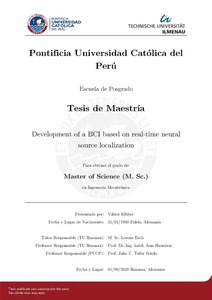Development of a BCI based on real-time neural source localization
Abstract
Brain-Computer-Interfaces (BCIs) provide a novel way of communication by interpreting
different types of brain states. This principle of reading minds makes BCIs a
challenging but at the same time fascinating topic among the different disciplines of
electrophysiology and biomedical-signal-processing.
This work describes the development of a non-invasive BCI approach using steadystate-
visual-evoked-potentials (SSVEP) as a mental strategy. SSVEP based BCIs require
an external visual stimulation, which in this work is transmitted by a LCD-screen.
Consequently, a visual reactive BCI is integrated as a plug-in into the open source
project MNE-CPP, which provides an extensive library for brain monitoring and processing.
MNE-Scan, as a standalone software from MNE-CPP, contains the necessary
real-time source localization and is used as a framework for the BCI. Moreover, an
expansion with a screen keyboard device shows the BCI’s practicability.
The work’s result delivers a functioning SSVEP BCI approach with an average detection
accuracy of 86 %. However, it is shown, that a transition from a BCI on sensor
level to a BCI on source level is challenging and requires a certain pre-development,
whereby a first approach of the BCI only was realized on sensor level in this work.
Temas
Interfaces cerebro-computadora
Electroencefalografía
Electroencefalografía
Para optar el título de
Maestro en Ingeniería Mecatrónica





